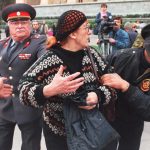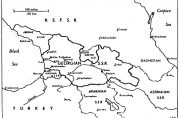Following Georgian calls for independence in the late 1980s, troops from the Soviet Ministries of Defense and Interior allegedly used toxic gas to break up a peaceful demonstration of 8,000 to 10,000 people in Tbilisi, Soviet Georgia on April 9, 1989. Sixteen people were known to have been killed at the scene, and four others died later from injuries sustained on that day. Hundreds of people were injured and admitted to hospitals.
Physicians for Human Rights was asked by Dr. Andrei Sakharov and Dr. Irakli Menagarishvili, Minister of Public Health for Soviet Georgia, to provide technical expertise in assessing the possibility that toxic gas had been used against the crowd. During a five-day investigation to Tbilisi in May 1989, a team of three PHR physicians found that Soviet troops used not just CN and CS, two commonly used tear agents, but a third toxic agent called chloropicrin as well. These three agents can cause skin and mucosal blisters, bronchoconstriction, and pulmonary edema. PHR’s detailed findings and recommendations from the investigation can found in the report “Bloody Sunday.”
PHR returned to Georgia roughly 20 years later, working with the International Rehabilitation Council for Torture Victims (IRCT) to train a new generation of health professionals to properly investigate and document torture in compliance with the Istanbul Protocol. From this partnership came the Model Curriculum on the Effective Medical Documentation of Torture and Ill-treatment, inspired by the IRCT’s Prevention through Documentation Project in which PHR also participated.



